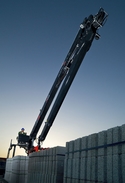ALLMI issues warning over delayed EN 12999
11 January 2010The UK’s Association of Lorry Loader Manufacturers and Importers (ALLMI) has said a delay to the implementation of the revised EN 12999 loader crane standard means manufacturers and importers across Europe must declare conformity directly against the Machinery Directive.
ALLMI technical director Alan Johnson said the implementation of EN 12999:2009 was due for December 2009 in order to ensure it met the requirements of the new Machinery Directive, which came into force on 29 December, 2009. This was delayed due to UNI, the Italian Organisation for Standardisation, lodging an appeal with CEN/CENELEC against the ratification of EN 12999:2009.
This, Johnson said in a memo to importers, installers, repairers and operators of lorry loaders, will mean the industry enters “something of a hiatus period”, as the existing A2 version of EN 12999 will not meet the Essential Health and Safety Requirements (EHSRs) of the new Machinery Directive. “Until such time that the new revised standard is available, manufacturers/importers will have to declare conformity directly against the EHSRs of the Machinery Directive,” Johnson said.
“We feel obliged to inform all importers, installers and operators that the delayed introduction of the revised standard does not negate the need to comply with the revised EHSRs of the new Machinery Directive; and that anyone supplying, or buying, a 2010 badged product needs to ensure this is done.”
In its appeal, UNI said it believes EN 12999:2009 ‘presents an insufficient level of safety for the intended field of application’, and that ‘there are matters arising from this standard which cannot fit the present situation of the European market’.
It has contested the use of a leakage free check valve as an automatic hydraulic locking device to secure the stabiliser extensions in the engaged position, as in Clause 5.4.3.3, as these can fail themselves, and ‘cannot control internal leakages in the system, possibly leading to hazards for pedestrians and other vehicles on the road due to uncontrolled openings of the stabiliser extensions while driving’.
In Clause 5.6.1.6, UNI said there is not a proper method specified to dimension the ropes, which could cause ropes to break, leading to serious hazards for operators; in Clause 5.6.1.1, UNI said the target minimum performance level of the system architecture of the RCL is not consistent with using hydraulic/electromechanical limiter technology, and would force a change in technology away from reliable hydraulic/electromechanical limiters; and additionally, UNI said, calculating the performance level of electronic safety devices is further inhibited by the components’ manufacturers being unable to provide the required mean time to failure values to crane manufacturers.
As a result, it wants mechanical automatic locking devices to be standard; the design of the rope to be in accordance with CEN/TS 13001-3-2; performance Level C with Category 1 on hydraulic/electromechanical safety limiter devices to apply; and a transitory period to be obtained to allow electronic safety device manufacturers to provide the necessary data to calculate the performance level.
A meeting of the CEN working group is to be held on 11 February to discuss UNI’s objections, where they will either be rejected or the standard modified as needed.
Johnson said the penalties for companies not ensuring they meet the EHSRs of the Machinery Directive could be great. In the UK he said, should the Health and Safety Executive (HSE) visit an operator who has taken delivery of a 2010 machine and find it doesn’t comply, the HSE’s powers would be such that it could prohibit the use of the machine and prohibit the importer from selling any more machines that don’t comply, and the supplier of the machine could face prosecution.
“Additionally, manufacturers need to be made aware that the HSE would also be legally obliged to enter details of any action onto a European database known as the ICMS system,” Johnson said. “This would flag the issue with all enforcement bodies in other member states which could result in that particular model/brand being prohibited from sale across Europe.”
